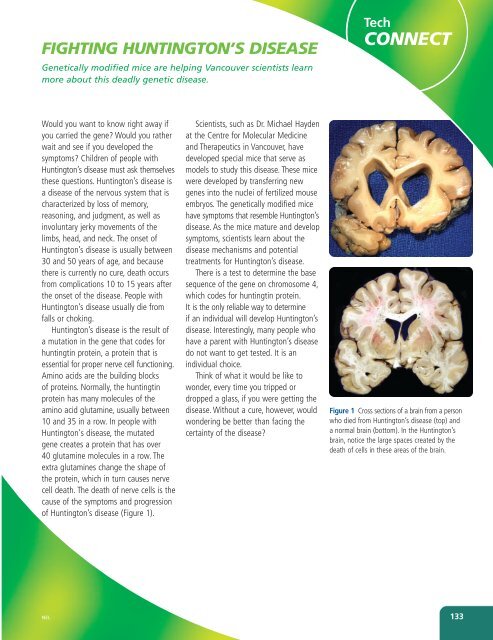Unit A Reproduction
Unit A Reproduction
Unit A Reproduction
Create successful ePaper yourself
Turn your PDF publications into a flip-book with our unique Google optimized e-Paper software.
FIGHTING HUNTINGTON’S DISEASE<br />
Genetically modified mice are helping Vancouver scientists learn<br />
more about this deadly genetic disease.<br />
Tech<br />
CONNECT<br />
Would you want to know right away if<br />
you carried the gene? Would you rather<br />
wait and see if you developed the<br />
symptoms? Children of people with<br />
Huntington’s disease must ask themselves<br />
these questions. Huntington’s disease is<br />
a disease of the nervous system that is<br />
characterized by loss of memory,<br />
reasoning, and judgment, as well as<br />
involuntary jerky movements of the<br />
limbs, head, and neck. The onset of<br />
Huntington’s disease is usually between<br />
30 and 50 years of age, and because<br />
there is currently no cure, death occurs<br />
from complications 10 to 15 years after<br />
the onset of the disease. People with<br />
Huntington’s disease usually die from<br />
falls or choking.<br />
Huntington’s disease is the result of<br />
a mutation in the gene that codes for<br />
huntingtin protein, a protein that is<br />
essential for proper nerve cell functioning.<br />
Amino acids are the building blocks<br />
of proteins. Normally, the huntingtin<br />
protein has many molecules of the<br />
amino acid glutamine, usually between<br />
10 and 35 in a row. In people with<br />
Huntington's disease, the mutated<br />
gene creates a protein that has over<br />
40 glutamine molecules in a row. The<br />
extra glutamines change the shape of<br />
the protein, which in turn causes nerve<br />
cell death. The death of nerve cells is the<br />
cause of the symptoms and progression<br />
of Huntington’s disease (Figure 1).<br />
Scientists, such as Dr. Michael Hayden<br />
at the Centre for Molecular Medicine<br />
and Therapeutics in Vancouver, have<br />
developed special mice that serve as<br />
models to study this disease. These mice<br />
were developed by transferring new<br />
genes into the nuclei of fertilized mouse<br />
embryos. The genetically modified mice<br />
have symptoms that resemble Huntington’s<br />
disease. As the mice mature and develop<br />
symptoms, scientists learn about the<br />
disease mechanisms and potential<br />
treatments for Huntington’s disease.<br />
There is a test to determine the base<br />
sequence of the gene on chromosome 4,<br />
which codes for huntingtin protein.<br />
It is the only reliable way to determine<br />
if an individual will develop Huntington’s<br />
disease. Interestingly, many people who<br />
have a parent with Huntington’s disease<br />
do not want to get tested. It is an<br />
individual choice.<br />
Think of what it would be like to<br />
wonder, every time you tripped or<br />
dropped a glass, if you were getting the<br />
disease. Without a cure, however, would<br />
wondering be better than facing the<br />
certainty of the disease?<br />
Figure 1 Cross sections of a brain from a person<br />
who died from Huntington’s disease (top) and<br />
a normal brain (bottom). In the Huntington’s<br />
brain, notice the large spaces created by the<br />
death of cells in these areas of the brain.<br />
NEL<br />
133

















